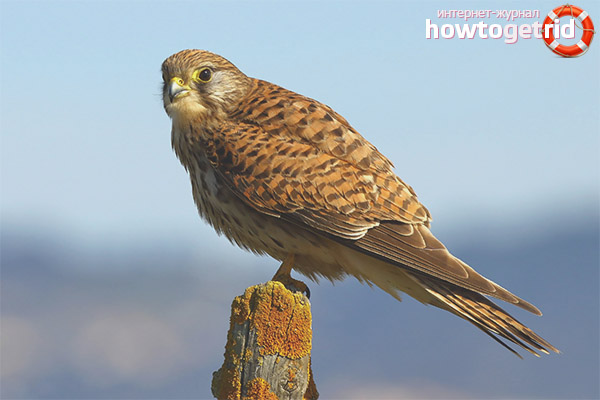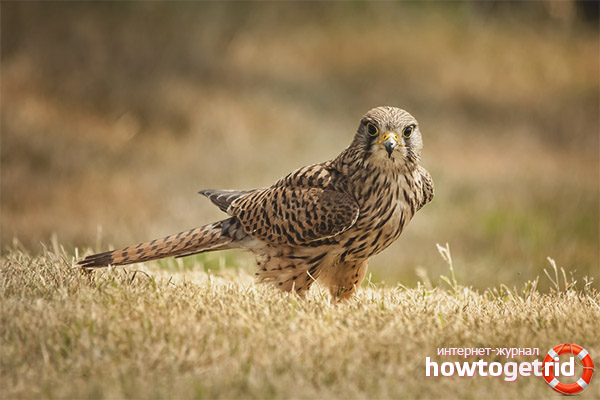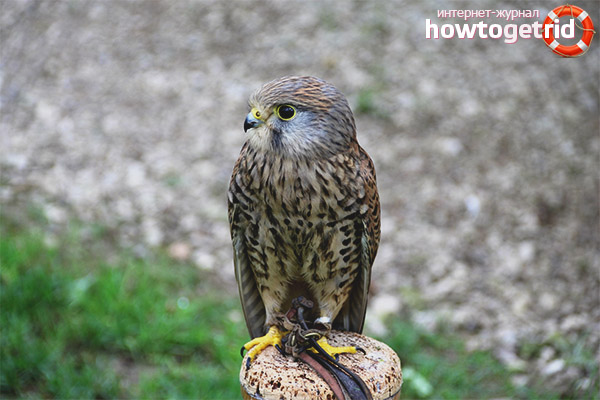The content of the article
“A fluttering flight of kestrels ...” - this is one of the most beautiful works of poetry. Indeed, the kestrel flight should not only be watched, it should be admired and admired. The bird is able to freeze in the currents of the headwind, to stay in the air masses, only slightly flapping its wings and remaining motionless relative to the ground. So the kestrel hunts - after all, the bird is a bird of prey and it needs prey. Common Kestrel is part of the order of falcon-like falcon family. The bird is quite common, it is even a symbol of the Russian Union for the Protection of Birds.
The scientific name of the bird - "Tininkulus" kestrel received for the peculiarity of its cry, which resembles the lingering sounds of "T-T-ti". In Russian, the etymological name comes from the word “pasture”, in past centuries the bird was more often called “pastelga” due to the fact that the predator preferred to soar in the air above the pastures, looking for prey. According to another version, the name of the bird "kestrel" comes from the word "empty, in vain." This implies the inability of the kestrel to falconry, unlike other representatives of the species. What a kestrel bird is, where it lives, how it breeds and what it eats, let's try to figure it out.
Kestrel Description
The male kestrel clearly differs from the female, primarily in the color of plumage on its head. The female has a brown color of plumage, almost brown. The male is characterized by pale gray shades. In addition, the male on the back has a large number of black speckles - diamond-shaped spots. At the end of the tail are black stripes with white bordering. The female does not have such ornaments, but on her plumage there is a transverse brown strip in the back and many small stripes at the level of the tail. External differences in plumage appear only after the onset of maturity, and before that, all kestrel teenagers look the same. The body length of the kestrel is about 30-35 cm, and the female is usually larger. The weight of the bird is about 300 grams. The more massive the female kestrel, the more numerous will be the clutch, such chicks are born more healthy and viable. This means that the large female will have much more suitors.
Kestrel habitat
Features of kestrel hunting

The possibility of a fluttering flight is a feature of the kestrel. The bird is able to freeze in a headwind so that it seems as if it were hung by invisible ropes. This amazing ability gives the falcon the ability to look out for prey over long distances. The bird has excellent vision, it can see a vole from a tremendous distance. As soon as the kestrel sees prey, it presses its wings to the body, down to the ground with a stone down and instantly catches the game with sharp claws. In the diet of kestrels, mice and other small rodents are most often found. A bird may attack other species of chicks. Kestrel is happy to relish lizards, moles and rats. In hungry periods, the kestrel will not refuse worms and other insects. Usually a falcon of this species hunts at an altitude of 10-40 meters above the ground, without rising above. In winter, during bad weather, the bird chooses for itself an observation post in the form of a tree on the field and it is from there that it looks for prey. Kestrel flies into the field with any movement seen, because feeding in the cold season is more difficult. Together with the caught prey, the kestrel returns to the shelter.
Breeding Kestrels
The mating season of the kestrel is very interesting for observation. During courtship, the male, as it were, attacks the female, flying with great force at her, but at the last moment stops in front of the lady of the heart. If the female is subjugated by such courtships, she begins to circle with the gentleman in the air. As such, kestrels do not build nests; they often arrange masonry in crevices of rocks, in various recesses. Often falcons occupy the abandoned nests of other birds. If the kestrel does not find anything suitable, the bird can settle right in the thickets of low vegetation.
The nesting period begins in April, and by the end of the month the female lays two to four eggs in the clutch. Mostly the female hatches eggs, it takes about a month. Chicks are born almost naked, mommy carefully warms them for 8-10 days until the first fluff appears. After that, the female begins to feed the offspring with the male. Parents bring the kids a mouse, nibble off pieces of fresh meat from the carcass and put the chicks in their beaks. Surprisingly, kestrel chicks do not open their beaks wide, as babies of other birds do. In the future, when the chicks grow up, the prey brought will not be cut. Parents will give the mouse to the children completely, then the most hungry and viable chick will manage the prey - all according to the laws of nature. In a month, when the chicks get stronger, the female will teach children to fly and hunt.
Interesting facts about Kestrel
Recently, the kestrel flies more and more to people, settles in the immediate vicinity, this makes it possible to openly observe the life and habits of beautiful falcons.
- Despite the active courtship on the part of the male, the female is still choosing a pair from the kestrel. She herself goes down to the chosen gentleman, makes certain sounds of “chucking”, after which the male decides to courtship. In order to win the attention of a beautiful lady, males often catch her prey for her, put a carcass at the bottom of the future nest. If the female accepts the gift, the lovers become a couple.
- The average life span of a kestrel is 16 years.
- The highest mortality of birds is observed in the harsh winter months, when feed becomes catastrophically small.
- Kestrel is not suitable for falconry, as it is unable to hunt in the air. This is rather an exception for birds of this species and family. For centuries, people have been trying to teach the kestrel to hunt other birds. But the strong craving for mice and rodents became irresistible for the kestrel.
- The number of birds of this species is quite high - in the world there are almost 2 million pairs of individuals.
- Man greatly appreciates the kestrel, as a bird destroys rodents that eat grain in the sown fields. Some time ago, kestrels were on the verge of extinction, since the bird is sensitive to pesticides that poisoned rodents. After the use of pesticides was banned, the bird population quickly recovered.
- Scientists notice the fact that in cities the laying of kestrels is less in number of chicks. In nature, chicks hatch more, by 30-40%.
Kestrel loves to settle on high towers, on the roofs of high-rise buildings and bell towers. The most famous pair of falcons found refuge on the tower of the Westminster Parliament in Britain. They did not dare to drive out the birds, they became a symbol of calm and stability.
Video: Kestrel Falcon (Falco tinnunculus)











Submit